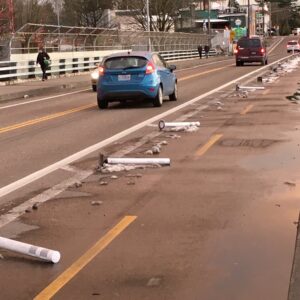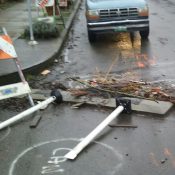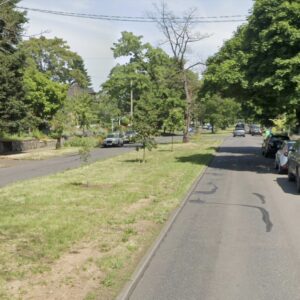
“If the plastic posts were ever protecting anyone to begin with, they aren’t doing it when they don’t stay in place for more than a few weeks at a time.”
— David Binnig
The thousands of plastic posts that delineate Portland bike lanes are perhaps a perfect symbol of our city’s commitment to bicycling and traffic safety. On one hand they show the transportation bureau respects bicycle riders and other vulnerable road users and that they know protecting bike lanes and building diverters is a key ingredient to boosting bike usage. But on the other hand, they don’t go far enough. By using a flimsy material for something meant to encourage people to drive less and protect them from collisions with multi-ton steel vehicles, the city shows they’re commitment to safety is more about aesthetics than outcomes.
These nearly-ubiquitous plastic posts (aka flex-posts, bollards, wands, or candlestick delineators) are good, but not great. And we desperately need great.
You probably either love or hate these posts. I love them when they stand stout and tall because they change driver behaviors and offer some protection (or at least a feeling of protection). But when I see them battered and uprooted, I get mad. I can feel a pit in my stomach that’s part frustration with PBOT for using them to begin with and part fear that my body will suffer the same fate.
Southeast Portland resident David Binnig is one of many volunteer activists who’ve made it a side hobby to track the fate of these posts they pass by each day. Back in March Binnig began to track the status of downed posts on the traffic diverter on SE Clinton and 17th. He snapped a photo in March. Then another in April. Then May. Then June. Then he emailed PBOT’s traffic safety request system at via safe@portlandoregon.gov. This email address is part of PBOT’s robust and very effective system for capturing complaints and fixing them. It works very well and we’ve shared several success stories over the years.
Advertisement
In August, Binnig heard back from PBOT that they’d upgrade the plastic wants to steel posts with more robust signs attached. The posts would still be breakaway-style (so fire trucks could go over them in an emergency), but they look stout enough that drivers are likely to avoid hitting them.
I asked Binnig to share more about his experience at this location and how he got PBOT to address it.
“I don’t think this particular location was the most important place — there are many, many intersections that are higher-priority in terms of safety,” he said, “but it was an egregious one it that it was pretty clear that drivers were deliberately ignoring the diverter and choosing to drive over it, as opposed to just misjudging their cornering.”
Because Binnig biked by regularly he knew the posts were being knocked down regularly and he had documentation of it happening for the past several years.
Asked if he hopes PBOT makes this upgrade elsewhere, Binnig said, “Yes. Everywhere.” Here’s more from his response:
“The reliance on plastic flex-posts is (in my view) a symptom of Portland’s lack of conviction on bicycling and road safety: We want to create an appearance of prioritizing safe routes without committing to anything that might scratch a car in the course of protecting someone on a bike. It’s also a problem in itself, when damaged posts allow drivers to cut corners or drive into bike lanes. If the plastic posts were ever protecting anyone to begin with, they aren’t doing it when they don’t stay in place for more than a few weeks at a time.”
As for using PBOT’s complaint system, Binnig has some thoughts about that too. “It’s just sort of absurd that we keep putting in road safety treatments that everyone knows are constantly knocked out of place and rely on random citizens complaining often enough to get them fixed. Lives aside, I suspect it’s penny-wise and pound-foolish to put in bike lane dividers that need constant maintenance to keep them in any functional shape.”
We agree.
And it’s an issue that goes way back. Remember the bollard debacle we reported on in 2012? When PBOT tried to protect the NW Lovejoy viaduct ramp down to NW 9th with plastic posts, only to have them uprooted and replaced so many times they eventually gave up? And like I shared in a 2016 opinion piece, if Portland is serious about cycling than we must get serious about cycling infrastructure.
Until then, bookmark this page and put safe@portlandoregon.gov and 823-SAFE in your contacts.
— Jonathan Maus: (503) 706-8804, @jonathan_maus on Twitter and jonathan@bikeportland.org
— Get our headlines delivered to your inbox.
— Support this independent community media outlet with a one-time contribution or monthly subscription.






Thanks for reading.
BikePortland has served this community with independent community journalism since 2005. We rely on subscriptions from readers like you to survive. Your financial support is vital in keeping this valuable resource alive and well.
Please subscribe today to strengthen and expand our work.
Thank you, David!
I wish I had the forethought to document the condition of the posts that line the separated bike lanes on N Rosa Parks. Over the past year, I think there are fewer and fewer of them that are still standing, but I never took photos of what they looked like fresh after installation. I’d love to see some more sturdy metal posts there, at least on the ends of the concrete separators.
I bet you Jonathan has some
I just looked at a May 2019 Google Street View at Rosa Parks and Omaha that shows intact-looking candlesticks.
I’ve used the historical Google Maps photos to document street changes for advocacy purposes before. The periodic intervals seem a bit random of when the Google trucks go through filming the street view, but sometimes you can get lucky and they have caught something from the past that no longer exists that you are looking to document.
And kudos to David Binnig! I ride past 17th and Clinton frequently and I sure did notice the nice new steel posts. Thank you!
Thank you, Dave, for being persistent. I agree that this intersection is not the most important but the visual of destroyed wands is anathema to safety no matter where they lie.
I also believe that complaint-driven fixes are inherently inequitable as they advantage those with time and resources. The absence of complaints ought not be interpreted as the presence of safe and just infrastructure for those not using a car.
Yes! This is a big concern of mine, as you know, Hami. How do we advocate to improve the problems we see without slowing repair to problems that might be even bigger that we don’t see?
Yes, I completely agree that the complaint-driven system is inequitable. In the bigger picture I think a goal should be to make these complaints less necessary. We know that plastic flex-posts are constantly run over; instead of fixing them ad hoc in the spots people like me complain about, I’d like to see PBOT use more durable diverters (or diverters that are a stronger deterrent to careless driving) everywhere in the city.
That goes for other parts of our street safety infrastructure—so far as possible the city should be following universal bright-line rules rather than making case-by-case decisions. That is, the question shouldn’t be whether Hawthorne gets a bike lane; the presumption should be that every street wider than x feet gets a bike lane whenever there’s repaving—and so on.
It’s probably inevitable that there will be some residuum of squeaky wheels getting grease, but I want to use particular complaints as bases for promoting more general change.
Yes, these complaint-driving systems are highly inequitable. Not only that but they set people up for potentially bad public interactions with others who might be the source of their complaint. Remember the “crosswalk Kathy” thing on Alberta? I can just imagine someone calling in an illegally parked massive pickup truck only to have the owner come out and take a few swings at them.
I love that PBOT is so responsive to these complaints/requests… but have very mixed feelings about it.
Would the alternative — not responding to complaints/requests — be better?
no. of course not. It’s a tricky situation. If we step far away and look back at it, the reason PBOT has this program is because they don’t have enough staff/funding to be more proactive about this type of stuff. In a functioning system, we’d have enough funding – or spend current funding differently – so that gov’t could keep up with safety/maintenance needs of the system. I’m afraid until we get more tax revenue and/or we stop wasting so much money perpetuating an unbalanced system that spends way to much on car use, this is the hand we have to play.
Staff can never know about everything in the city, so there will always be a role for the public to report problems. Instead of worrying that the ability to report gives some people and “unfair advantage”, how about focusing on ways to make reporting easier?
I’m afraid you are misunderstanding my thoughts on this.
I totally support the 823-SAFE system and my track record on this site makes that very clear. I think it’s possible to both like and appreciate something, but also have concerns about it at the same time.
And you say, “How about focusing on ways to make reporting easier?” Oh, do you mean like creating an platform read by many thousands of people every day and then using that platform to educate them about this reporting system and then sharing direct links to said system so that people can easily make their own reports?
I’m aware of someone who regularly reports any and all of the tiniest problems at a nearby residential intersection. I don’t think that one intersection in a relatively quiet neighborhood should have so much more PBOT staff time because one person who works at home fills out complaints all the time.
This doesn’t mean that folks shouldn’t report problems that they see. But we need to make sure the system doesn’t perpetuate and exaggerate inequities.
exactly. couldn’t agree more. AFAIK PBOT hasn’t done a great job building systems and checks into their processes to weed out inequities like this. There’s still a lot of squeaking wheels getting grease, but that type of system could be better. To be clear, I sympathize with PBOT on this! It’s hard to get this balance right and it’s hard to serve a city fairly and efficiently.
Maybe I misunderstood this: “These complaint-driving systems are highly inequitable.” That suggests that the current systems have barriers to use, or perhaps give improper priority to certain classes of residents. I was saying that the way to address that is to lower barriers to remove the inequity.
Considering complaints can be made with a phone call, I don’t see how the system is biased to those with more resources or time.
My feeling is that those that make such complaints have so few other problems that complaining about bike infrastructure becomes “really important” and that those with fewer resources have such significant challenges facing them every day so making complaints about the material used for traffic diverters must seem pretty silly.
I was so impressed with the approach to this in Vancouver, BC when I visited a few years ago. Bike lines on busy roads were often separated from cars by concrete barriers. It was ugly and incredibly effective, and clearly much safer than any bollard.
Thank you David!! Time for Portland to entirely close certain streets (Clinton please) to auto traffic.
If you live on Clinton, would you then be required to become car-free?
No why?
Because “_entirely_ close” would seem to include the residents. But of course they could park cars on nearby streets and walk/roll in.
Personally, I’ve been driving more than riding lately, for a number of personal reasons. I make it a point not to drive in cycle lanes, even/especially when coming up to a right-hand turn, preferring to wait until the paint on the bike lane stops/becomes dotted to make my turn, and I don’t much care if other drivers find me frustrating to drive behind. On the other hand, many, many drivers make it a habit to use the bicycle lane as a right-hand turn lane, or a parking lane or whatever. It doesn’t surprise me, therefore, that plastic wands get run over on a regular basis. I was driving with my husband recently when he complained about the new wands at the intersection of N Wall and N Houghton – I suggested taking the next street (N. Hudson), but that seemed unfathomable. Some road users just don’t want to inconvenience themselves just a little for other people.
I’ve only seen them in two locations but PBOT also has the option of installing a loop of ¼” steel cable that stands about a foot above a glue mounted plastic speed bump and appears to be designed to grab air dams, trim, and stray suspension bits. It’s a bit wicked, I’m surprised they don’t use it more.
Certainly making the posts out of metal is an option. I mean cars cannot possibly knock down a metal post, unless it is smaller than 6” in diameter (maybe).
On the other hand when I’m riding my bike, my greatest fear is hitting ANY kind of post, especially short metal ones not painted with bright yellow paint.
Next we can discuss the chain across the road in Delta Park that has nothing hanging from it to make it very visible. But that chain hasn’t been up for awhile.
I completely disagree with the premise that the posts are intended to “encourage people to drive less and protect them from collisions with multi-ton steel vehicles.”
The premise of bike lanes is based around predictability not protection. As with all road striping, paint on the road is intended to inform and direct traffic along streets in an orderly/safe fashion. To suggest any/all bike lanes or diverters need to be constructed to “stop” a car is ludicrous.
I think about this anytime I drive down a two-lane highway. Roads like OR26 or OR8 to the coast or SR14 east of Washougal. These roads see endless lines of traffic passing each other 5-feet apart and traveling at high speeds. We regularly hear of head on collisions and loss-of-life yet I don’t see jersey barriers being installed. Rumble strips have been installed as a means of alerting drivers crossing the double yellow line but does that just show ODOT/WSDOT’s “commitment to safety is more about aesthetics than outcomes”?
I can agree that if plastic bollards at a specific location are regularly mowed down they are not performing as they should and change should be made. But even with the posts at 17th at Clinton getting regularly crushed, was anyone ever injured? Even with the posts crushed and on the ground, I am guessing 99% of cars were diverted off Clinton as was intended.
Diverters need to be big/solid enough to effectively discourage people from just driving over them in their big SUVs/Pickups. I think these metal ones do a great job of that. Plus they are breakaway, so expect that to happen at some point.
As for barriers on highways U.S.26 and SR14, I’d say they’re roads operating a bit beyond their initial designs. As they turn into freeways, they are slowly getting barriers as budgets and projects allow. See the massive safety projects on the section of 26 between Sandy and Govt. Camp that was/is infamous for crossover crashes.
With highways, it’s not as simple as just adding some barriers in the middle of the road. Fortunately, with city streets, it usually IS that simple for adding protection to bike lanes!
I’d imagine that the decision to beef up the diverter is based on the cost in time and materials for replacing them each time they are destroyed…and nothing to don with safety since no one is injured.
Thank you so much David. As sad as it is that people have to yell at PBOT to do basic safety, I’m glad that in this case the advocacy was successful.
Somebody on twitter commented that ‘the only thing that causes drivists to adhere to safe practices is the risk of scratching their car.’
It is sooo true.
One more install issue to consider…when to install the new class of wands/ vertical plastic delineators…now that their connection to the bases are stronger and can take multiple hits so now the “time” they are installed may need to be considered. In a recent protected bike lane project – not in Portland – the newly installed delineators (bases with 4 lag screws) were popping out within the first month after strikes in multiple project locations. The issue to keep an eye on may be to avoid installing such in newly paved roadways…especially without using adhesive.
BUT overall the critical issue in this AND many other US projects is the potentially ‘inappropriate’ new application of a product (wand / verticle delinator) that was originally developed for either low speed strikes (parking facilities) or for moderate speed roadways with limited hits…but combining higher speeds with higher frequency strike events has pushed this type of product into a higher failure rate…thus a design decision then becomes an operations / maintenance burden. Thus potentially undermining the long term adoption of this class of traffic safety mobility project within cities.
The next generation of protected bikeways really needs to go back to square one and not be afraid to use a blend of harder fixed buffers (concrete barriers / curbing / wheel stops) and mountable low profile plastic objects (‘hedgehog’ / ‘zebra’ / ‘Texas turtle’ / ‘Dallas city titty’)…to avoid the current issues that this blog post has raised in the Portland case.